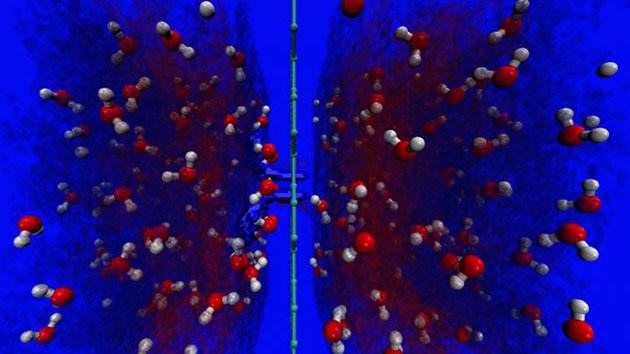graphene
Latest

Six next-gen battery technologies
By Cat DiStasio We all love our battery-powered gadgets, but portable power cells can be devastating to the environment. Fortunately, recent developments have proven that greener batteries are coming in the not-too-distant future. Engineers are replacing toxic components with less harmful materials ranging from leaves to sugar. Other innovations on the rise look to nature to help make batteries last longer, perform better and leave less of a trace once they've been discarded. This gold nanowire-based battery, for instance, was created by accident and could make lithium ion batteries obsolete, while this single-use battery dissolves in water when its job is done, making it easier to reuse its components.

Researchers push Moore's Law with a 1-nanometer transistor gate
Ready for some hardcore science about transistor elements that are a fraction of the width of a human hair? Good, because that's what this post is all about. "The semiconductor industry has long assumed that any gate below 5 nanometers wouldn't work, so anything below that was not even considered," University of California at Berkeley researcher Sujai Desay says. In recent years, though, that assertion has looked shaky, and now it's been thoroughly disproved thanks to the discoveries made by scientists at UC Berkeley and the magic of carbon nanotubes. Or, as they're more commonly known, graphene.

Fisker teases an electric sports car with a 400 mile range
Henrik Fisker is back in the news with another electric car company. Fisker Inc. (not to be confused with Karma Revero) is the latest venture from the famed designer. Aside from claims that the electric sports car will travel over 400 miles between charges, there won't be anything to see until halfway through next year, according to a report from Bloomberg. "It will definitely be something that when you see it, it will look completely different," Fisker (the person) tells the publication. "It will be sporty and spacious." He hopes to take on the Tesla Model S with the first vehicle, which he describes as a spiritual successor to the 2012 Karma.

Graphene key to promising treatment for spinal cord injuries
Graphene seems to have almost limitless potential, from making better batteries to night-vision windshields and microscopic sensors. And now, a team at Rice University has shown the material could be key to a promising new treatment for severe spinal cord injuries.

Test-driving LELO's 'condom of the future'
I'm not proud of it. As someone who's at high risk for HIV infection, I have a spotty relationship with safe sex. I came of age in the '90s, when rappers like Salt-N-Pepa and Lisa "Left Eye" Lopes frequently spit rhymes about rubbers. I volunteered in a South African AIDS orphanage in the early 2000s and saw first-hand the effects of unprotected sex. I even had my own close brush with HIV infection nearly 10 years ago. And yet, I don't always do the right thing. NSFW Warning: This story may contain links to and descriptions or images of explicit sexual acts.

Graphene e-paper is brighter and bendier
Who said that e-paper was old stuff? Certainly not China -- the country's Guangzhou OED Technologies has created what it says is the world's first graphene-based e-paper. The extremely strong yet light material promises very thin screens that are both brighter and more flexible. You could get e-readers that are easier to read on a sunny day, for instance, or activity trackers that can put up with more abuse. It should even be less expensive, as graphene's carbon is much easier to find than the exotic indium metal you see in conventional e-paper.

Solar cell generates power from raindrops
Rain is normally a solar energy cell's worst nightmare, but a team of Chinese scientists could make it a tremendous ally. They've developed a solar cell with an atom-thick graphene layer that harvests energy from raindrops, making it useful even on the gloomiest days. Water actually sticks to the graphene, creating a sort of natural capacitor -- the sharp difference in energy between the graphene's electrons and the water's ions produces electricity.

Graphene could bring night vision to phones and cars
Thermal imaging devices like night-vision goggles can help police, search-and-rescue teams and soldiers to pick out bad guys or victims through walls or in complete darkness. However, the best devices require cryogenic cooling, making them heavy, expensive and slow. Enter graphene, the semi-conducting material that's 100 times stronger than steel -- researchers from MIT have built a chip out of the material that may solve the problem. The resulting infrared sensors were small enough that they could be "integrated in every cellphone and every laptop," according to the study's co-author, Tomas Palacios.

Watch this graphene paper slither around like it's alive
Researchers from China have taken shape-memory materials to a creepy new level with a self-folding paper that can propel itself by "walking." Sorcery? Not quite. It's actually made from everybody's favorite wonder-material, graphene, and heated by an infrared laser that causes active regions to contract, then expand when it shuts off. By placing the regions in strategic locations, the team can make the paper move in any direction. It isn't going to put a scare into Sarah Connor just yet, but the team thinks it could one day be used to create contracting "muscles" that do power murderous 'bots. In the near term, the material could lead to low-cost temperature and humidity sensors.

Graphene kirigami could lead to flexible, nanoscale machines
Graphene's looking more and more like an all-around wonder material that can be used to make armor tougher than kevlar, thin light bulbs, long-lasting batteries and even high-tech tattoos. Now, a team of Cornell physicists have discovered that they can make kirigami out of 10-micron sheets (a hair strand's 70-micron-thick, for comparison) of graphene, as well. Kirigami is the art of cutting out designs on a single piece of paper like in the image above. The ones made by the Cornell team are much, much smaller -- they're quite literally nanoscale versions of what you see above -- but since they're made of the wondrous one-atom-thick material, they're also incredibly strong.

'3D' white graphene could revolutionize gadget cooling
Graphene seems to be the new millennium's wonder material: it can be used to build more powerful processors, more efficient solar cells, better sounding headphones and, apparently, can even be deep-fried to create long-lasting batteries. Now, researchers at Rice University think that a "3D" variant of the material could change the way we cool our gadgets.

Samsung's next-gen tech would nearly double your phone's battery life
Don't like that your Galaxy S6 conks out before you're finished for the day? Samsung might offer some relief in the future. Its scientists have developed lithium-ion battery technology that promises much longer-lasting power packs. They use a silicon anode (which promises much more capacity than a typical battery), but grow layers of graphene on top to improve the density and longevity that would otherwise suffer. In experiments, they got batteries that were 1.5 to 1.8 times denser than what you get today. If your smartphone barely makes it 12 hours before giving up the ghost, this would theoretically give you 21 hours -- enough that you wouldn't have to panic if you forgot to plug in before bedtime.

The world's thinnest light bulb is made from graphene
Forget LED light bulbs... in the future, your lighting may be made from carbon. Columbia University researchers have built a light bulb chip that superheats graphene to produce illumination. While that's the same basic concept that you see in an incandescent bulb, the graphene filament measures just one atom thick -- this is the world's thinnest light bulb, and may be close to being the thinnest possible. It's transparent, too, which could suit it to see-through displays.

Nanotube-soaked spiders spin super-strong silk
Orb spider silk, already among the toughest and strongest materials found in nature, could soon get a super-strong nanoscale upgrade. A research team from the University of Trento, Italy recently sprayed 15 Orb-weaving spiders, members of the Pholcidae family, with carbon nanotube or graphene particle solutions. They found that doing so caused some of the spiders to spin even stronger silk than what they normally do. The team administered five spiders with a graphene-water solution and another 10 with a carbon-water mix. While some spiders subsequently spun sub-par silk (and four of them died outright), a few of the carbon-dosed arachnids actually produced strands 3.5 times stronger than the most resilient natural silk we know about.

'Defective' graphene makes for super-efficient fuel cells
Though graphene is noted for its beautiful symmetry, when you add a few warts and imperfections, it becomes more interesting -- specifically, it has the potential to make fuel cells better and cheaper. Scientists from Northwestern University and other institutions were toying with the material as a hydrogen fuel cell membrane, and found that by knocking out at least four carbon atoms from the normally pristine structure, it performed vastly better. A large number of protons (and nothing else) slipped through imperfections in the atom-thick material in just a few seconds, efficiently generating electricity.

Scientists build silicon transistor just one atom thick
Step aside, graphene, "silicene" is the trendy new nano-material in town that could one day supercharge future tech. Scientists have created the world's first transistor out of the silicon-based material, and it's a mere one atom thick. Unlike its much-maligned graphene cousin -- which has yet lived up to its vast potential -- silicene is a much more interesting material for computer scientists. Thanks to the silicon base, it can form "band gaps" necessary for transistors, which could one day lead to faster chips that consume less power.

Deep-fried graphene may be the key to long-lasting batteries
The deep frying process isn't just useful for livening up your food -- it might also be the ticket to better batteries in your mobile devices. South Korean researchers have created highly conductive, stable electrode materials by spraying graphene oxide droplets into a very hot blend of acid and organic solvent, much like you'd dip chicken into oil. The resulting "pom-poms" (what you see above) aren't at all tasty, but their open 3D structure makes them far better for transferring electrical charges than plain graphene.

Graphene stronger than kevlar when blasted with Mach 9 microbullets
Here's another new use for graphene (that will probably never happen): stopping bullets. University of Massachusetts-Amhers researchers have found that everybody's favorite potential wonder-material vastly outperforms steel and even kevlar armor. Testing the ultra-lightweight, 1-atom thick carbon sheets has proved tricky in the past, as they disintegrated on contact with regular bullets. So, the team used laser pulses to fire micron-sized glass bullets into the sheets at around 6,700 mph, about three times the speed of an M16 bullet (see below). Sheets from 30 to 300 layers thick absorbed the impacts much better than the other materials by deforming into a cone shape, then cracking.

Graphene circuits double as high-tech temporary tattoos
Someday, you might be able to stick a temporary tattoo on your skin that's wired to light up or act as a display -- one that's made out of hybrid graphene. If you regularly read Engadget, then you're most likely familiar with graphene: It's that ultra-thin miracle material companies and researchers are using to develop tough and flexible experimental devices these days. The hybrid graphene structures used to make these electronic tattoos, however, are lot more stretchable and transparent, so they continue to work even if you fold them or pull them taut. In addition to acting as a tattoo for purely aesthetic purposes, this material developed by Korean scientists from Ulsan National Institute of Science and Technology (UNIST), Korea Advanced Institute of Science and Technology (KAIST) and Electronics and Telecommunications Research Institute (ETRI) have other possible applications. It can also be used as a biosensor to monitor people's health or to make flexible displays and circuits.

Atom-scale brain sensors will show exactly how your mind works
Neural activity maps frequently present an incomplete picture of how a brain works; you can measure electrical activity, stimulate it or visualize the anatomy, but you can't do all three. DARPA and the University of Wisconsin might just pull off that seemingly impossible feat, however. They recently built a hybrid brain sensor that combines both electrical and optical techniques to present a vivid picture of what's happening inside the mind. The sensor is primarily made of ultra-thin graphene (just four atoms thick) that both conducts electricity and lets light through. By putting this device on top of neural tissue, you can simultaneously create brain activity and monitor virtually every aspect of it. Graphene is safe for your body, too, so you shouldn't face the same risks you see with metal alloys.








